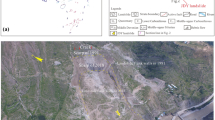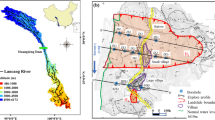Abstract
The deformation and failure mechanism of landslides caused by reservoir water operations is a significant problem that is being addressed by researchers. The Xiaochatou Landslide in the Wudongde Reservoir area is taken as an example for the performance of centrifugal model tests under gravel conditions with the rapid drawdown of the reservoir water level. The data concerning the displacement and pore water pressure during this process show that the Xiaochatou Landslide, which is a complex landslide containing a shallow slide mass, middle slide mass and deep slide mass, is extremely sensitive to the rapid drawdown of the water level. The centrifuge tests show that the shallow slide mass will fail and that the middle slide mass will suffer a large displacement after a rapid decrease in the reservoir water level. Furthermore, the Xiaochatou Landslide exhibits the characteristics of retrogressive failure.














Similar content being viewed by others
References
Baker R, Rydman S, Talesnick M (1993) Slope stability analysis for undrained loading conditions. Int J Numer Anal Methods Geomech 17:15–43
Berilgen MM (2007) Investigation of stability of slopes under drawdown conditions. Comput Geotech 34:81–91
Bishop AW (1954) The use of pore pressure coefficients in practice. Geotechnique 4:148–152
Cividini A, Gioda G (1984) Approximate F. E. analysis of seepage with a free surface. Int J Numer Anal Methods Geomech 8:549–566
Dawson EM, Roth WH, Drescher A (1999) Slope stability analysis by strength reduction. Geotechnique 49(6):835–840
Desai CS (1972) Seepage analysis of earth banks under drawdown. J Soil Mech Found Div 98(11):1143–1162
Desai CS (1977) Drawdown analysis of slopes by numerical method. J Geotech Eng Div 103(6):667–676
Duncan JM, Wrigth SG, Wong KS (1990) Slope stability during rapid drawdown. In: Proceedings of the H. Bolton seed memorial symposium, vol 2, pp 253–272
Duncan JM, Wright SG, Brandon TL (2014) Soil strength and slope stability. Wiley, Hoboken, New Jersy
Gong WP, Wang L, Khoshnevisan S, Juang CH, Huang HW, Zhang J (2014) Robust geotechnical design of earth slopes using fuzzy sets. J Geotech Geoenviron Eng 141(1):04014084
Griffiths DV, Lane PA (1999) Slope stability analysis by finite elements. Geotechnique 49(3):387–403
Hu XL, Zhang M, Sun M et al (2015) Deformation characteristics and failure mode of the Zhujiadian landslide in the Three Gorges Reservoir, China. Bull Eng Geol Environ 74(1):1–12
Jia GW, Zhan TL, Chen YM, Fredlund DG (2009) Performance of a large-scale slope model subjected to rising and lowering water levels. Eng Geol 106(1):92–103
Jiang JW, Ehret D, Xiang W, Rohn J, Huang L, Yan SJ, Bi RN (2011) Numerical simulation of Qiaotou Landslide deformation caused by drawdown of the Three Gorges Reservoir, China. Environ Earth Sci 62:411–419
Jiao YY, Zhang HQ, Tang HM et al (2014) Simulating the process of reservoir-impoundment-induced landslide using the extended DDA method. Eng Geol 182:37–48
Kim JM, Sitar N (2013) Reliability approach to slope stability analysis with spatially correlated soil properties. Soils Found 53(1):1–10
Lane PA, Griffiths DV (2000) Assessment of stability of slopes under drawdown conditions. J Geotech Geoenviron Eng 126(5):443–450
Li SJ, Knappett JA, Feng XT (2008) Centrifugal test on slope instability influenced by rise and fall of reservoir water level. Chin J Rock Mech Eng 27(8):1586–1593
Liao HJ, Sheng Q, Gao SH, Xu ZP (2005) Influence of drawdown of reservoir water level on landslide stability. Chin J Rock Mech Eng 24:3454–3458
Liu XX, Xia YY, Lian C, Zhang KP (2005) Research on method of landslide stability valuation during sudden drawdown of reservoir level. Rock Soil Mech 26(1427–1431):1436
Lowe J, Karafiath L (1960) Stability of earth dams upon drawdown. In: Proceedings of the first Panamerican conference on soil mechanics and foundation engineering, Mexico City, vol 2, pp 537–552
Lowe J, Karafiath L (1980) Effect of anisotropic consolidation on the undrained shear strength of compacted clays. Paper presented at research conference on shear strength of cohesive soils. American Society of Civil Engineers, Boulder, CO
Luo XQ, Liu DF, Wu J et al (2005) Model test study on landslide under rainfall and reservoir water fluctuation. Chin J Rock Mech Eng 24(14):2476–2483
Morgenstern NR (1963) Stability charts for earth slopes during rapid drawdown. Geotechnique 13:121–131
Pauls GJ, Karlsauer E, Christiansen EA, Wigder RA (1999) A transient analysis of slope stability following drawdown after flooding of highly plastic clay. Can Geotech J 36:1151–1171
Picarelli L, Versace P, Olivares L et al (2009) Prediction of rainfall-induced landslides in unsaturated granular soils for setting up of early warning systems. In: Proceedings of the 2007 International Forum on Landslide Disaster Management, vol 1, Hong Kong, pp 643–665
Qi SW, Yan F, Wang S (2006) Characteristics, mechanism and development tendency of deformation of Maoping landslide after commission of Geheyan reservoir on the Qingjiang River, Hubei Province, China. Eng Geol 86(1):37–51
Reinius E (1954) The stability of the slopes of earth dams. Geotechnique 5:181–189
Stephenson D (1978) Drawdown in embankments. Geotechnique 28:273–280
Skempton AW (1954) The pore pressure coefficients A and B. Geotechnique 4:143–147
Svano G, Nordal S (1987) Undrained effective stability analysis. In: Proceedings of the ninth European conference on soil mechanics and foundation, Dublin
US Army Corps of Engineers (2003) Engineering and design manual—slope stability. Engineer Manual EM 1110-2-1902, Department of the Army, Corps of Engineers, Washington (DC)
Wang HL, Xu WY (2013) Stability of Liangshuijing landslide under variation water levels of Three Gorges Reservoir. Eur J Environ Civ Eng 17:S158–S173
Wang SJ, Ma FS, Du YL (1996) On the rock–water interaction in reservoir areas and its geoenvironmental effect. J Eng Geol 4(3):1–9
Wang ST, Liu HC, Zhang ZY et al (1997) Research on the water rock interaction and its environmental effects in reservoir areas. J Geol Hazards Environ Preserv 8(1):69–89
Wang L, Hwang JH, Juang CH, Atamturktur S (2013) Reliability-based design of rock slopes—a new perspective on design robustness. Eng Geol 154:56–63
Wright SG, Duncan JM (1987) An examination of slope stability computation procedures for sudden drawdown. US Army Corps Engineering. Waterway Experiment Station, Vicksburg
Yin YP, Peng XM (2007) Failure mechanism on Qianjiangping landslide in the Three Gorges Reservoir region. Hydrogeol Eng Geol 34(3):51–54
Acknowledgments
Financial assistance from the National Natural Science Foundation of China through research Grant Nos. 41472265 and 51308067 are gratefully acknowledged. The valuable advice from the two reviewers is greatly appreciated.
Author information
Authors and Affiliations
Corresponding author
Rights and permissions
About this article
Cite this article
Fan, L., Zhang, G., Li, B. et al. Deformation and failure of the Xiaochatou Landslide under rapid drawdown of the reservoir water level based on centrifuge tests. Bull Eng Geol Environ 76, 891–900 (2017). https://doi.org/10.1007/s10064-016-0895-1
Received:
Accepted:
Published:
Issue Date:
DOI: https://doi.org/10.1007/s10064-016-0895-1




